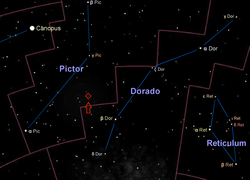Our website is made possible by displaying online advertisements to our visitors.
Please consider supporting us by disabling your ad blocker.
HD 40307
| Observation data Epoch J2000.0 Equinox J2000.0 (ICRS) | |
|---|---|
| Constellation | Pictor |
| Right ascension | 05h 54m 04.24050s[1] |
| Declination | −60° 01′ 24.4930″[1] |
| Apparent magnitude (V) | 7.17[2] |
| Characteristics | |
| Spectral type | K2.5V[2] |
| B−V color index | 0.93[2] |
| Astrometry | |
| Radial velocity (Rv) | 31.08±0.12[1] km/s |
| Proper motion (μ) | RA: −52.174±0.023 mas/yr[1] Dec.: −60.059±0.025 mas/yr[1] |
| Parallax (π) | 77.3261 ± 0.0170 mas[1] |
| Distance | 42.179 ± 0.009 ly (12.932 ± 0.003 pc) |
| Absolute magnitude (MV) | 6.57±0.01[3] |
| Details | |
| Mass | 0.75+0.03 −0.04[4] M☉ |
| Radius | 0.716 ± 0.010[5] R☉ |
| Luminosity (bolometric) | 0.23[6] L☉ |
| Luminosity (visual, LV) | 0.20[note 1] L☉ |
| Surface gravity (log g) | 4.47 ± 0.16[6] cgs |
| Temperature | 4977 ± 59[6] K |
| Metallicity [Fe/H] | −0.31 ± 0.03[6] dex |
| Rotation | 31.8±6.7 d[7] |
| Rotational velocity (v sin i) | 3[4] km/s |
| Age | 1.2 (≥ 0.2)[4] Gyr |
| Other designations | |
| Database references | |
| SIMBAD | data |
| Exoplanet Archive | data |
| ARICNS | data |
HD 40307 is an orange (K-type) main-sequence star located approximately 42 light-years away in the constellation of Pictor (the Easel), taking its primary name from its Henry Draper Catalogue designation. It is calculated to be slightly less massive than the Sun. The star has six known planets, three discovered in 2008[2][8] and three more in 2012. One of them, HD 40307 g, is a potential super-Earth in the habitable zone, with an orbital period of about 200 days. This object might be capable of supporting liquid water on its surface, although much more information must be acquired before its habitability can be assessed.[9][10][11][12]
No stellar companions to HD 40307 were detected as of 2018.[13]
- ^ a b c d e Cite error: The named reference
GaiaDR3was invoked but never defined (see the help page). - ^ a b c d e Cite error: The named reference
sbwas invoked but never defined (see the help page). - ^ Cite error: The named reference
cgssn09was invoked but never defined (see the help page). - ^ a b c HD 40307, database entry, Geneva-Copenhagen Survey of Solar neighbourhood, J. Holmberg et al., 2007, CDS database V/117A, accessed November 19, 2008; described in The Geneva-Copenhagen survey of the Solar neighbourhood. Ages, metallicities, and kinematic properties of ~14 000 F and G dwarfs, B. Nordström, M. Mayor, J. Andersen, J. Holmberg, F. Pont, B. R. Jørgensen, E. H. Olsen, S. Udry, and N. Mowlavi, Astronomy and Astrophysics 418 (May 2004), pp. 989–1019, Bibcode:2004A&A...418..989N, doi:10.1051/0004-6361:20035959.
- ^ HD 40307, entry, CDS database J/A+A/450/735; described in Effective temperature scale and bolometric corrections from 2MASS photometry, E. Masana, C. Jordi, and I. Ribas, Astronomy and Astrophysics 450, #2 (May 2006), pp. 735–746. Bibcode:2006A&A...450..735M. doi:10.1051/0004-6361:20054021.
- ^ a b c d M. Mayor; S. Udry; C. Lovis; F. Pepe; D. Queloz; W. Benz; J.-L. Bertaux; et al. (2009). "The HARPS search for southern extra-solar planets. XIII. A planetary system with 3 Super-Earths (4.2, 6.9, & 9.2 Earth masses)". Astronomy and Astrophysics. 493 (2): 639–644. arXiv:0806.4587. Bibcode:2009A&A...493..639M. doi:10.1051/0004-6361:200810451. S2CID 116365802.
- ^ Cite error: The named reference
mnras452_3_2745was invoked but never defined (see the help page). - ^ Jeanna Bryner (June 16, 2008). "Three super-Earths found around one star". NBC News. Archived from the original on December 13, 2013. Retrieved June 18, 2008.
- ^ Amina Khan (November 7, 2012). "Possible Earth-like planet could hold water; scientists cautious". Los Angeles Times. Retrieved November 8, 2012.
- ^ Tuomi, Mikko; Anglada-Escudé, Guillem; Gerlach, Enrico; Jones, Hugh R. A.; Reiners, Ansgar; Rivera, Eugenio J.; Vogt, Steven S.; Butler, R. Paul (17 December 2012). "Habitable-zone super-Earth candidate in a six-planet system around the K2.5V star HD 40307". Astronomy & Astrophysics. 549: A48. arXiv:1211.1617. Bibcode:2013A&A...549A..48T. doi:10.1051/0004-6361/201220268. S2CID 7424216.
- ^ Wall, Mike (November 7, 2012). "'Super-Earth' Alien Planet May Be Habitable for Life". Space.com. Retrieved November 8, 2012.
- ^ Tate, Karl (November 7, 2012). "Super-Earth Planet: Potentially Habitable Alien World Explained (Infographic)". Space.com. Retrieved November 8, 2012.
- ^ Dietrich, J.; Ginski, C. (2018). "Archival VLT/Na Co multiplicity investigation of exoplanet host stars". Astronomy & Astrophysics. 620: A102. arXiv:1811.09666. Bibcode:2018A&A...620A.102D. doi:10.1051/0004-6361/201731341. S2CID 119294338.
Cite error: There are <ref group=note> tags on this page, but the references will not show without a {{reflist|group=note}} template (see the help page).
Previous Page Next Page



